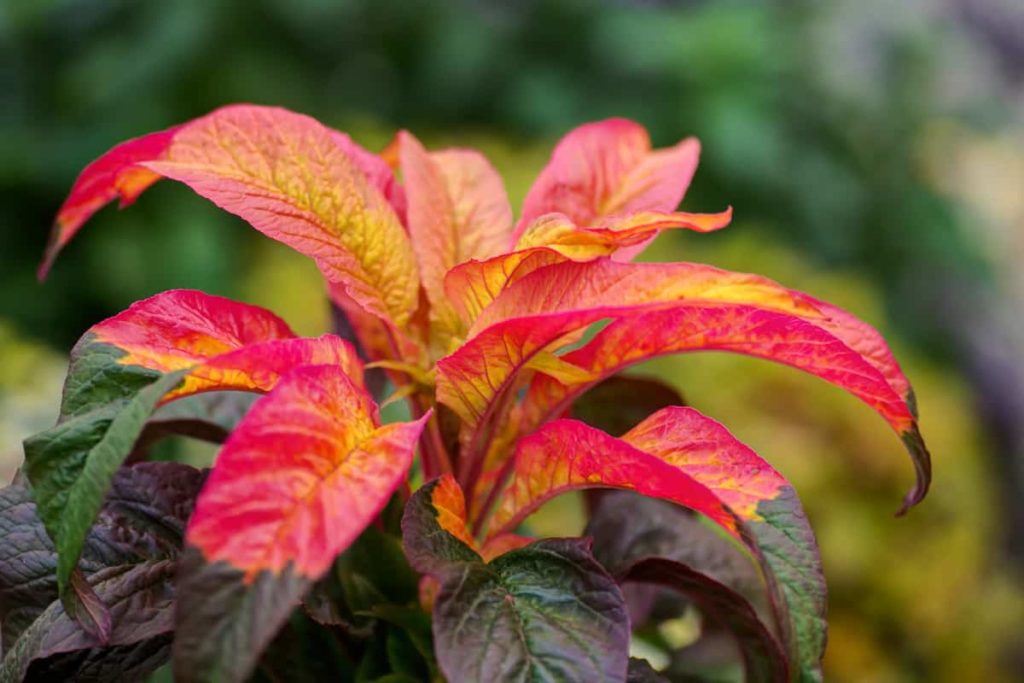
Spring and summer are considered the most colorful times of the year. Bright and soft pastels take over your garden and you’re treated to a sea of color.
Let’s not forget fall, when various shades of browns, reds, and oranges warm up your space as temperatures drop. But what if I told you that you could have bursts of color no matter the season?
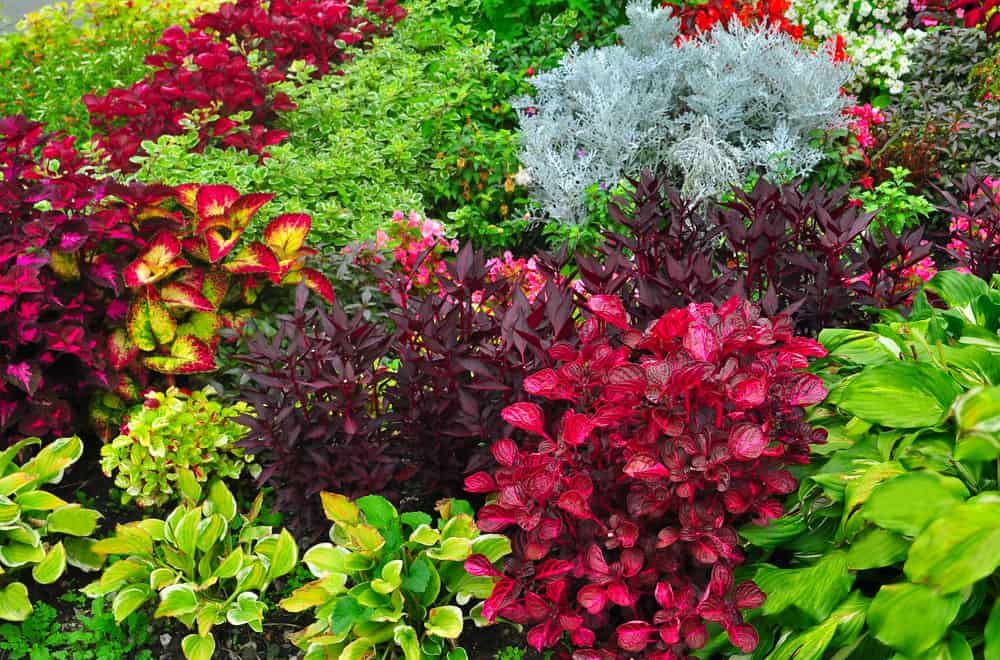
Make an impact all year round with colorful foliage plants. From brightening up a shady spot or adding a pop of color and texture to your favorite bed, the leaves of these thirteen plants boast permanent displays of stunning colors. As a bonus, some of them may even flower too.
1. Hosta
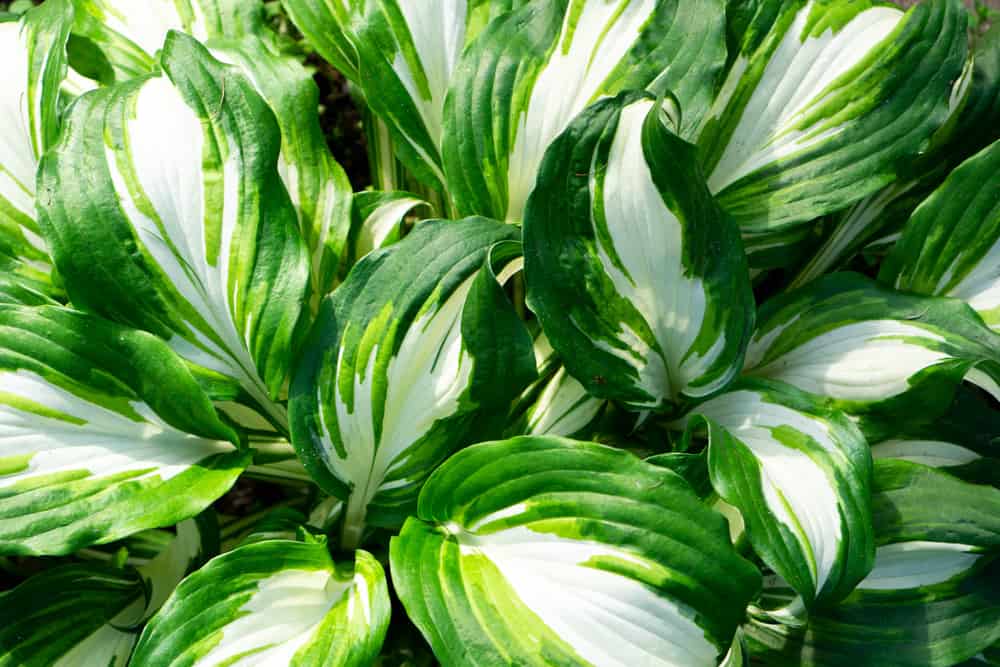
First on our list are hostas. This interesting plant is one of the most popular plants in home gardens. You’ll easily recognize hostas’ large green leaves with their many patterns and textures.
For a classic hosta look, the ‘Minuteman’ variety is ideal, with its big, deep green leaves and thick white borders. They’re a favorite because they subtly add life and thrive in shady areas.
But the perfect hosta for year-round color is the ‘Fire Island’ variety. Its luminous yellow leaves keep shady spots bright and happy all year. Its vibrance even shifts as the seasons change, becoming a cooler yellow resembling chartreuse. Direct sunlight during the morning and shady afternoons bring out the best in this happy hosta.
2. Coleus

Coleus has interesting textures with a wide range of colors that brighten any garden design and make a big impact. Its compact height makes it a great container plant. It also adds vivid splashes of color to flower beds and patio gardens.
Back in the day, coleus was a shade-loving plant. But newer varieties enjoy showing off their bright colors in full sun. From solid reds, pinks, and yellows, to mixes of various brilliant hues, sun-loving coleus keeps your garden bright and summery.
Some varieties, like ‘Black Dragon’, have leaves that scream autumn. Their deep burgundy leaves have ruffled edges too, adding interesting color and texture to any space.
Go big in your garden with Kong series coleus. Their 6-inch leaves cover gardens beds perfectly while adding splashes of color.
3. Amaranthus Tricolor
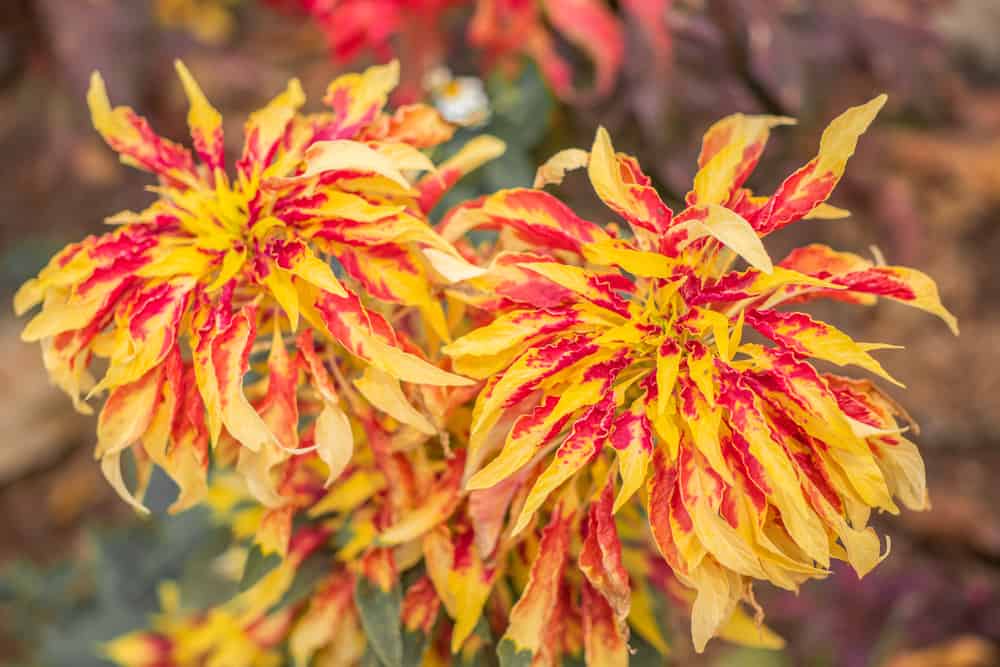
You’ll probably know this bold plant as Joseph’s coat. Even though this variety of amaranth does grow flowers, its foliage is the star of the show. Yellows, reds, and oranges bleed into green, creating a unique picturesque spectacle. Whether you plant amaranthus tricolor in beds or containers, this plant gives year-round color like no other.
Make sure your amaranthus tricolor gets as much sun as possible. The more sun it gets, the more brilliant its foliage will be.
4. Ninebark
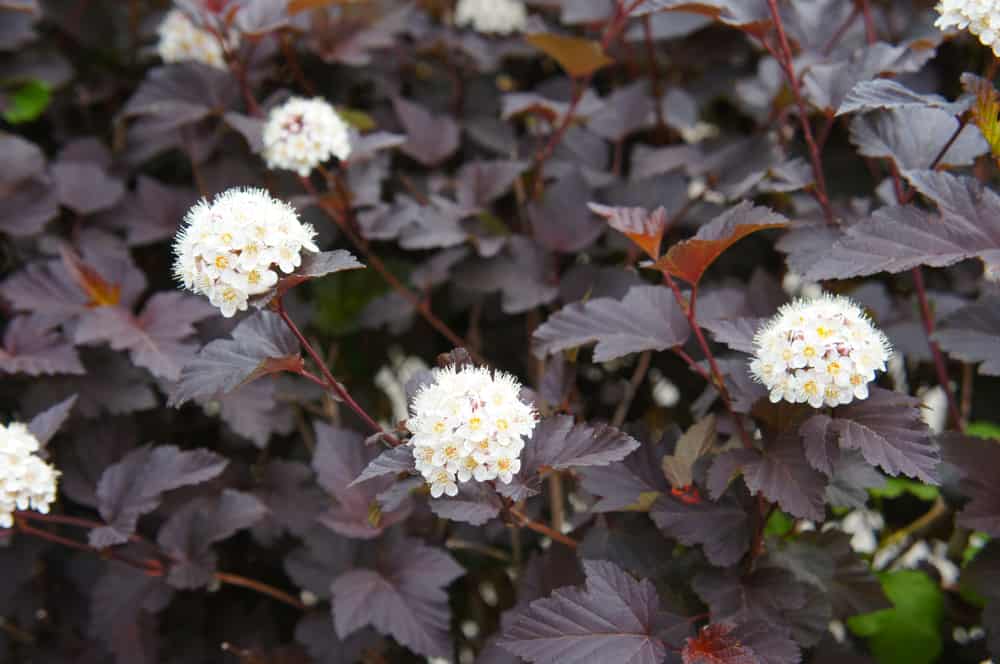
Ninebark is a unique perennial shrub. Its pink and white flowers are quaint and pretty, but its foliage is the standout. Ninebark’s textured leaves are green, yellow, and dark red, creating intrigue in any space.
If dark reds and burgundy are your styles, then the ‘Diablo’ variety is the perfect plant for you. In spring, its pops of pinkish-white flowers stand out against the dark leafy background.
A brighter variety of ninebark is ‘Darts Gold’. In summer, its leaves are a stunning yellow-green. But in spring, you’ll have a golden shrub that appears to belong at the end of a rainbow.
No matter the variety, ninebark keeps your garden interesting. From bright shifting colors to cute little flowers, your garden will be ever-changing, while staying ever-colorful.
5. Coral Bells
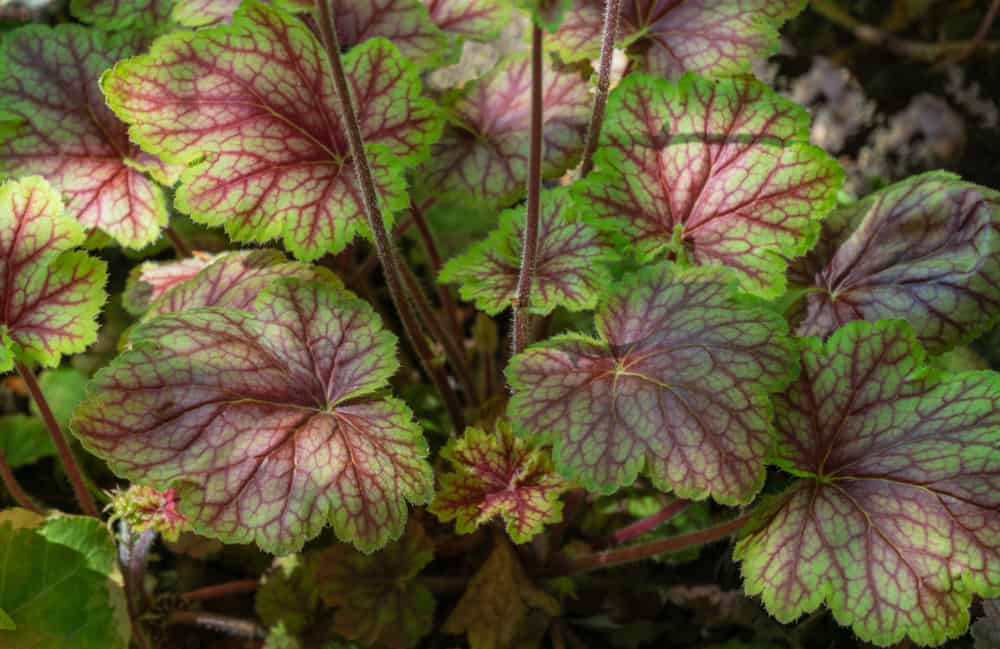
Known by the genus Heuchera, coral bells are a low-growing shrub that charmingly sprinkle fall across your landscape. Its assortment of colored leaves makes a subtle statement in any garden. From purple to orange and golden greens, you won’t be disappointed. Some varieties even boast their brilliance with multi-colored leaves.
Coral bells are favored for their bright colors, but their textured leaves add the true interest. Depending on the variety, you could be treated with splotchy, veiny, or even speckled leaves.
This lovely bright plant adds even more life during summer with its sweet flowers. Its white blooms top long red spikes, adding some height to your beds. In warmer months these flowers attract some great pollinating guests too. Hummingbirds and butterflies seem to love coral bells as much as we do.
6. Smoke Tree
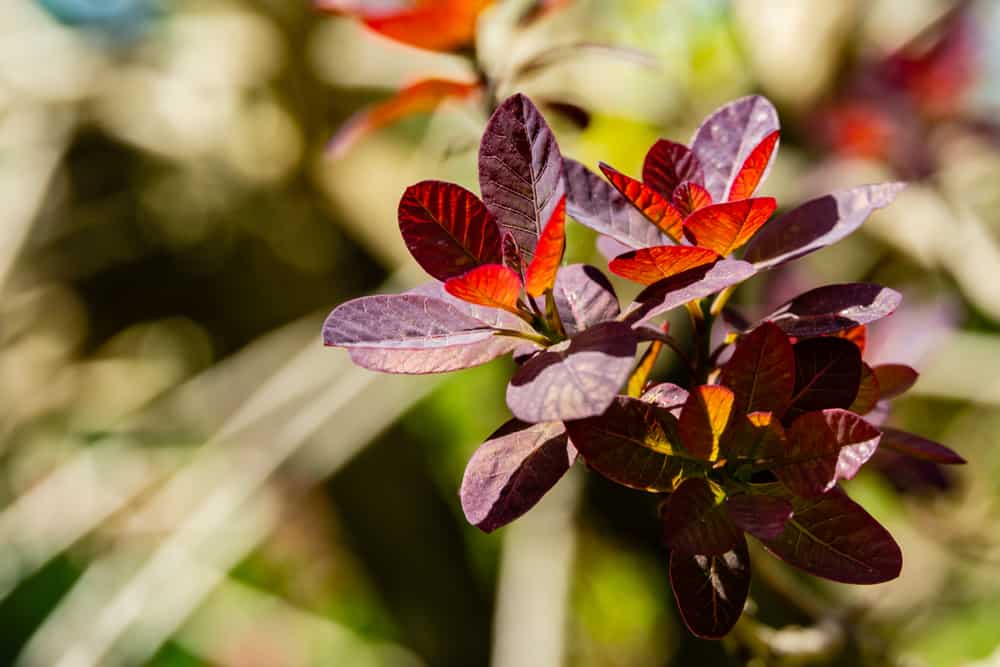
The smoke tree (Cotinus coggygria) is a wonderful shrub or to add to your landscape. Its oval leaves bring a touch of fall to your garden all year. When it comes to colored foliage though, the purple varieties of this plant are most popular.
‘Redsmoke’, ‘Royal Purple’, or ‘Velvet Cloak’ have velvety foliage that boast rich purple hues. Come flowering time, these deep tones perfectly complement its yellow blooms.
The best thing about the smoke tree is that it thrives in any soil type, as long as it’s well-draining. It also isn’t too phased about the soil pH and, once established, tolerates dry conditions. Purple smoke trees grow best in USDA zones 4 to 9, but they prefer warmer, drier climates.
7. Begonia
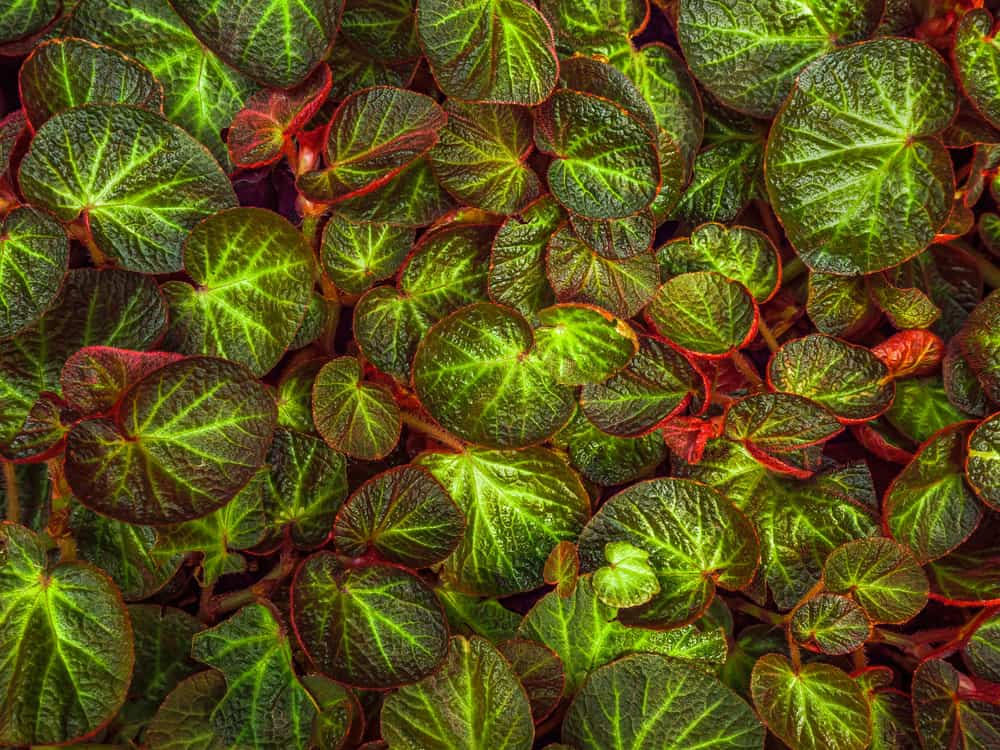
A colorful foliage list would be incomplete without the addition of the beloved Begonia. There are thousands of begonia varieties, most popular for their adorable flowers and glossy green leaves. However, indoor plant lovers will already know Begonia rex., a category of begonias with fascinating foliage.
Not only do they come in a range of colors, from dusty greens to cool purples and deep reds, but the way they display these colors is of particular interest. Begonia rex leaves feature entrancing patterns tough to find on any other plant. The common name ‘painted-leaf begonia’ tells you all you need to know.
Preferring shade and the most tropical of climates, these are not the easiest foliage plants to care for. However, when grown indoors, their particular requirements can be better catered to, allowing their stunning shades to shine.
8. Croton
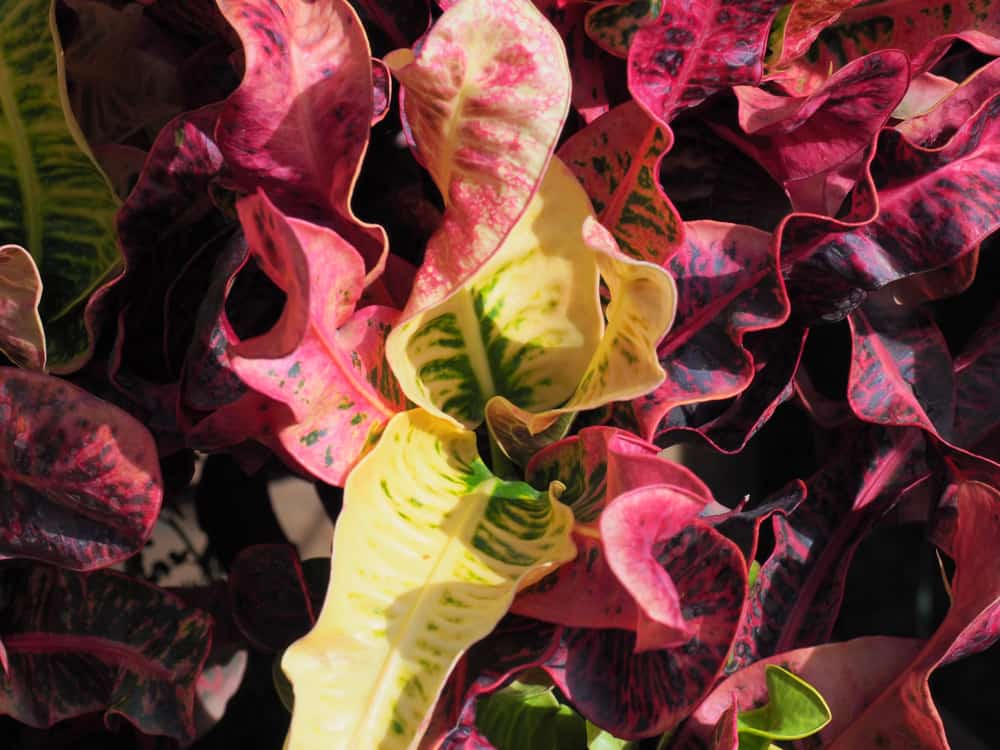
Croton is a plant that burns itself into memory. It has various fiery colors that are sure to set any garden ablaze.
The ‘Gold Star’ variety has thin, spikey, yellow dotted leaves that add spots of gold to your space. Another popular variety is ‘Petra’. It has bright oval leaves with uniquely colored veins that make a remarkable statement.
This plant is hardy between USDA zones 9 and 11, meaning that it’s quite sensitive to colder winters. The easiest way to keep your crotons happy and bright during the cooler months is to plant them in movable containers. When the temperatures start dipping, move your crotons inside or to a sheltered area.
If you’d prefer to have its interesting textures in your beds, you could cover it. Covering plants with frost covers protects them from cold weather over winter. Crotons planted outdoors tend to be on the thirsty side, thriving in moist soil. They also shine their best in bright, dappled light throughout the day.
9. Canna
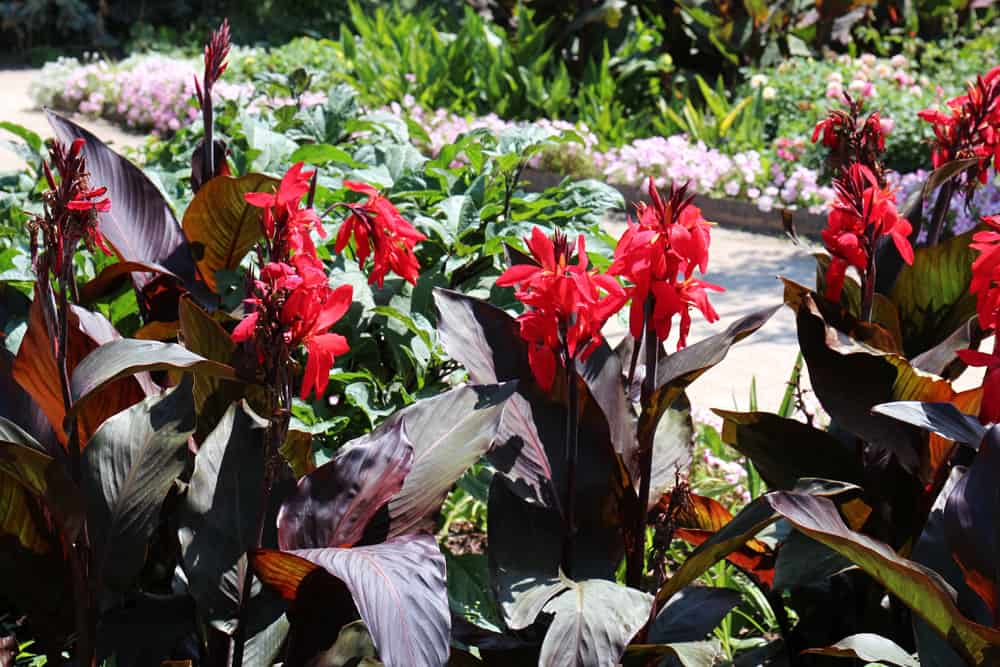
Canna lilies complete a garden perfectly, making any space a tropical paradise. Their stunning flowers and tall leaves are usually enough to draw anyone in. But some varieties take it one step further.
Certain canna lily varieties boast vibrant foliage with interesting patterns that lighten and add texture to your landscape.
‘Red King Humbert’, for example, has burgundy leaves that complement its bright red flowers. Its deep-hued leaves keep a piece of fall in your garden, even in the height of summer.
‘Louis Cotton’ is another variety with cooler tones. Its edges are red, gently fading into dark green. A subtle but no less stunning contender is the ‘Cleopatra’ variety. Its bright green leaves are dashed with purple stripes.
If you’re wanting a touch of summer, ‘Red Stripe’ does exactly that. True to its name, reds, oranges, and touches of yellow streak across its large green leaves.
10. Caladium
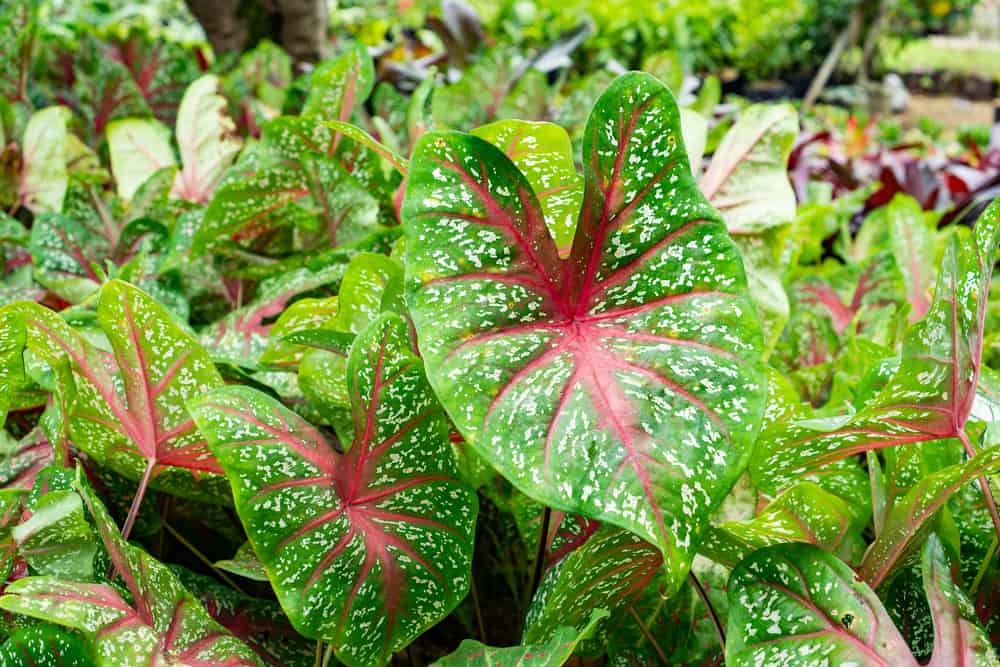
Caladiums offer lovers of green leaves a colorful twist. You’ll probably know these plants as ‘Angel Wings’. They serve up unique mixes of green, pink, and white on their large leaves. A single plant features a plethora of leaves, sporting different splashes of colors and patterns.
Caladiums bring light and life to gardens, brightening shaded areas the best – from partial to full shade.
This unique plant adds a touch of softness to textured beds or containers. They look great alongside irises and a variety of spiky ornamental grasses, or can be combined with other soft textures like ferns for a more harmonious design.
11. Dusty Miller
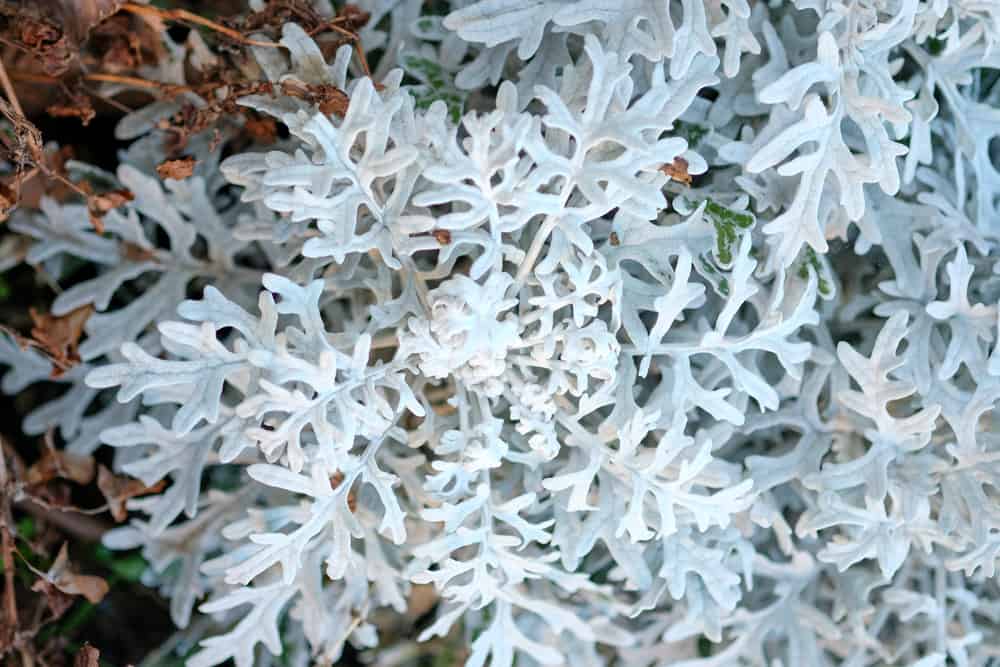
For a completely different style and look, consider adding Dusty Miller to your garden. Not only do its leaves disrupt big bushy flower beds, but its bright silvery-white color stands out like no other. Reducing this plant to a filler plant does Dusty Miller no justice.
‘Cirrus’ has broader leaves than other varieties. It’s sure to add a dramatic splash of white across the base of your colorful flower bed. ‘Silver Lace’ on the hand is as delicate as the name implies, perfect for gardens needing a subtle color neutralizer.
‘Silverardo’ is the most popular among the different varieties with its fern-like leaves.
The best thing about Dusty Miller is that its silver-white hues complement any color. It will brighten your flower beds all year, stealing the attention.
12. Sweet Potato Vine
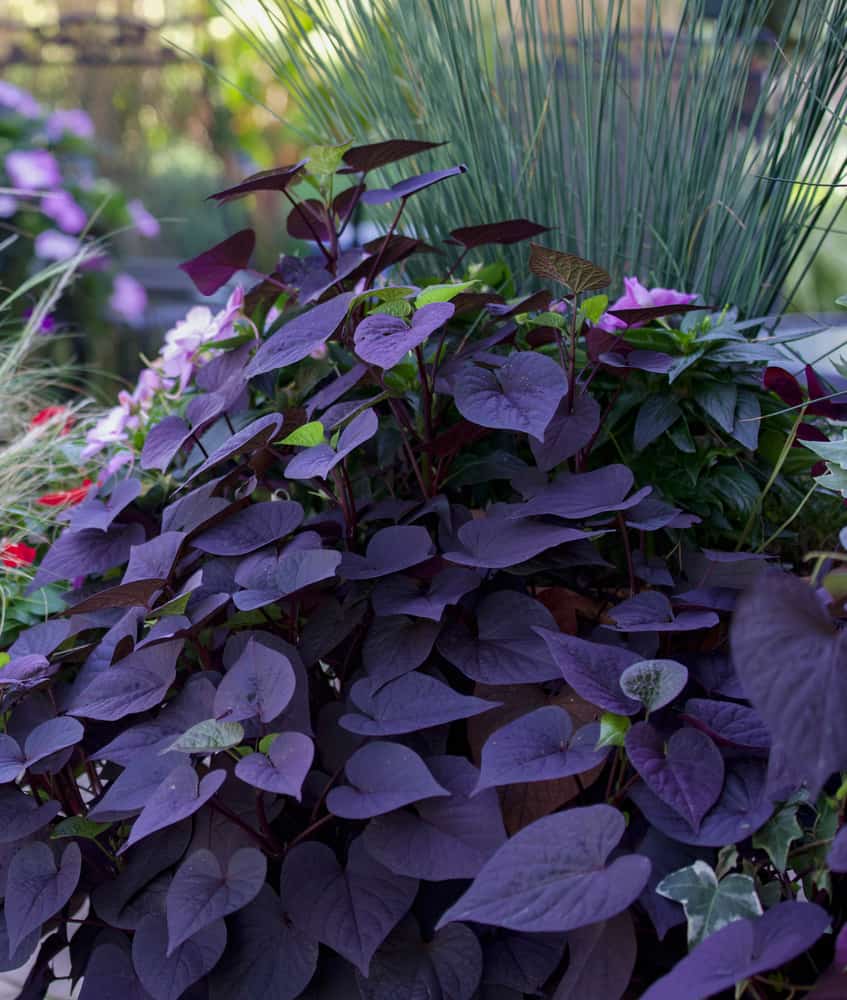
Sweet potato vine is a popular container and ground covering plant. Although it’s related to the edible sweet potatoes, the bulb from which they grow is not tasty. Instead, it’s grown for its brightly colored and interestingly shaped foliage. Ornamental sweet potato vine adds texture and splashes of summer colors to your garden.
Different varieties offer different colors for your evergreen garden. ‘Sweet Caroline’ has maple leaf-shaped foliage that can be purple, bronze, yellow, and even red. It adds a touch of summer all year while getting the Neil Diamond classic stuck in your head every time you admire them.
For fall admirers, you can opt for the ‘Blackie’ variety. It too sports maple-shaped leaves, but they’re a striking dark purple. Come flowering time, you’ll also be treated with lovely purple trumpet-like flowers.
‘Ragtime’ offers subtle purple colors year-round, but its leaves are narrower than other varieties, adding a different shape to your garden beds.
13. Cordyline
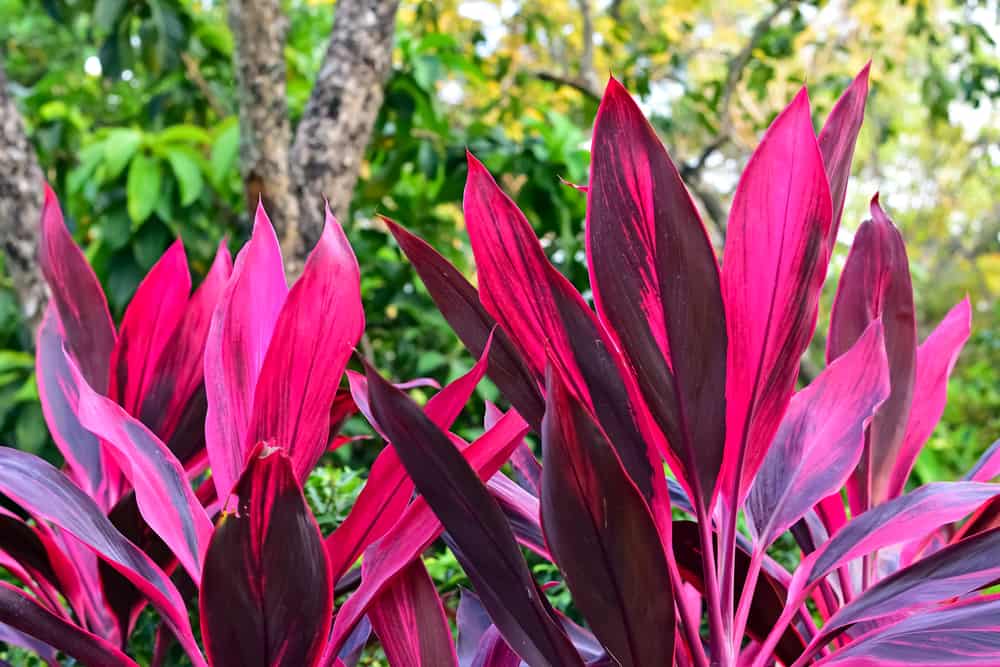
Cordyline, more commonly known as the Ti plant, is famous for its colorful tropical leaves. This eastern-Asian native plant is considered a ‘good luck plant’ with mystical powers. According to legend, you were more fortunate if your Ti plant boasted several stalks.
Certain varieties brighten your garden with deep purples and reds, like the ‘Hawaiian Boy’. ‘Florida Red’, with splashes of soft pink. The ‘Candy Cane’ variety does indeed resemble a candy cane. Its large green leaves have streaks of pink and white across them.
For some added spikiness, grow the ‘Pink Pasion’. Its long sword-like leaves are bright purple-pink with vibrant pink edging.
Cordylines love the sun and will stay their brilliant bright selves all year round so long as they get plenty of light.
No garden should be without splashes of color. After all, color is one of the greatest joys of gardening. The best way to keep your landscape bright year-round is foliage. The colored leaves of these thirteen plants brighten up spaces, with some adding colorful flowers to the mix too.
